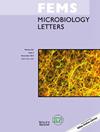Analysis of CRISPR-Cas loci distribution in Xanthomonas citri and its possible control by the quorum sensing system
IF 2.2
4区 生物学
Q3 MICROBIOLOGY
引用次数: 0
Abstract
Xanthomonas is an important genus of plant-associated bacteria that causes significant yield losses of economically important crops worldwide. Different approaches have assessed genetic diversity and evolutionary interrelationships among the Xanthomonas species. However, information from clustered regularly interspaced short palindromic repeats (CRISPR) has yet to be explored. In this work, we analyzed the architecture of CRISPR-Cas loci and presented a sequence similarity-based clustering of conserved Cas proteins in different species of Xanthomonas. Although absent in many investigated genomes, Xanthomonas harbors subtype I-C and I-F CRISPR-Cas systems. The most represented species, Xanthomonas citri, presents a great diversity of genome sequences with an uneven distribution of CRISPR-Cas systems among the subspecies/pathovars. Only Xanthomonas citri subsp. citri and Xanthomonas citri pv. punicae have these systems, exclusively of subtype I-C system. Moreover, the most likely targets of the X. citri CRISPR spacers are viruses (phages). At the same time, few are plasmids, indicating that CRISPR/Cas system is possibly a mechanism to control the invasion of foreign DNA. We also showed in X. citri susbp. citri that the cas genes are regulated by the diffusible signal factor (DSF), the quorum sensing (QS) signal molecule, according to cell density increases, and under environmental stress like starvation. These results suggest that the regulation of CRISPR-Cas by QS occurs to activate the gene expression only during phage infection or due to environmental stresses, avoiding a possible reduction in fitness. Although more studies are needed, CRISPR-Cas systems may have been selected in the Xanthomonas genus throughout evolution, according to the cost-benefit of protecting against biological threats and fitness maintenance in challenging conditions.分析柠檬黄单胞菌中 CRISPR-Cas 基因座的分布及其可能受法定量感应系统的控制
黄单胞菌是一种重要的植物相关细菌属,它给全球具有重要经济价值的农作物造成了严重的产量损失。不同的方法评估了黄单胞菌物种间的遗传多样性和进化相互关系。然而,来自聚类规则间隔短回文重复序列(CRISPR)的信息尚待探索。在这项工作中,我们分析了CRISPR-Cas基因座的结构,并提出了基于序列相似性的黄单胞菌不同物种中保守Cas蛋白的聚类。尽管在许多被研究的基因组中都不存在,但黄单胞菌中存在I-C和I-F亚型CRISPR-Cas系统。最具代表性的物种--柠檬黄单胞菌(Xanthomonas citri)的基因组序列具有极大的多样性,其亚种/变种之间的 CRISPR-Cas 系统分布不均。只有柠檬黄单胞菌(Xanthomonas citri subsp.此外,X. citri CRISPR spacers 最可能的目标是病毒(噬菌体)。同时,很少有质粒,这表明 CRISPR/Cas 系统可能是一种控制外来 DNA 入侵的机制。我们还在 X. citri susbp. citri 中发现,随着细胞密度的增加,以及在饥饿等环境胁迫下,cas 基因会受到可扩散信号因子(DSF),即法定量感应(QS)信号分子的调控。这些结果表明,QS对CRISPR-Cas的调控仅在噬菌体感染或环境胁迫时才会激活基因表达,从而避免可能出现的适应性降低。尽管还需要进行更多的研究,但在整个进化过程中,CRISPR-Cas系统可能是黄单胞菌属根据抵御生物威胁和在挑战性条件下维持适应性的成本效益而选择的。
本文章由计算机程序翻译,如有差异,请以英文原文为准。
求助全文
约1分钟内获得全文
求助全文
来源期刊

Fems Microbiology Letters
生物-微生物学
CiteScore
4.30
自引率
0.00%
发文量
112
审稿时长
1.9 months
期刊介绍:
FEMS Microbiology Letters gives priority to concise papers that merit rapid publication by virtue of their originality, general interest and contribution to new developments in microbiology. All aspects of microbiology, including virology, are covered.
2019 Impact Factor: 1.987, Journal Citation Reports (Source Clarivate, 2020)
Ranking: 98/135 (Microbiology)
The journal is divided into eight Sections:
Physiology and Biochemistry (including genetics, molecular biology and ‘omic’ studies)
Food Microbiology (from food production and biotechnology to spoilage and food borne pathogens)
Biotechnology and Synthetic Biology
Pathogens and Pathogenicity (including medical, veterinary, plant and insect pathogens – particularly those relating to food security – with the exception of viruses)
Environmental Microbiology (including ecophysiology, ecogenomics and meta-omic studies)
Virology (viruses infecting any organism, including Bacteria and Archaea)
Taxonomy and Systematics (for publication of novel taxa, taxonomic reclassifications and reviews of a taxonomic nature)
Professional Development (including education, training, CPD, research assessment frameworks, research and publication metrics, best-practice, careers and history of microbiology)
If you are unsure which Section is most appropriate for your manuscript, for example in the case of transdisciplinary studies, we recommend that you contact the Editor-In-Chief by email prior to submission. Our scope includes any type of microorganism - all members of the Bacteria and the Archaea and microbial members of the Eukarya (yeasts, filamentous fungi, microbial algae, protozoa, oomycetes, myxomycetes, etc.) as well as all viruses.
 求助内容:
求助内容: 应助结果提醒方式:
应助结果提醒方式:


